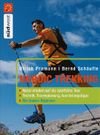
-
 Anglický jazyk
Anglický jazyk
Climbing techniques
Autor: Source: Wikipedia
Source: Wikipedia. Pages: 110. Chapters: Abalakov thread, Abseiling, Australian rappel, Autoblock, Belaying, Edging (climbing), Fast-roping, Fixed rope, Front pointing, Garda hitch, Gaston (climbing), Glissade (climbing), Headpoint, Lead climbing, List of... Viac o knihe
Na objednávku
25.70 €
bežná cena: 29.20 €
O knihe
Source: Wikipedia. Pages: 110. Chapters: Abalakov thread, Abseiling, Australian rappel, Autoblock, Belaying, Edging (climbing), Fast-roping, Fixed rope, Front pointing, Garda hitch, Gaston (climbing), Glissade (climbing), Headpoint, Lead climbing, List of climbing techniques, Mantle (climbing), Mountaineering, Multi-pitch climbing, On-sight climbing, Pinkpoint, Pole climbing (gymnastic), Redpoint (climbing), Retro-bolting, Self-belay, Single Rope Technique, Smearing, South African Abseil, Spotting (climbing), Top roping, Traverse climbing, Tyrolean traverse. Excerpt: Mountaineering or mountain climbing is the sport, hobby or profession of hiking, skiing, and climbing mountains. While mountaineering began as attempts to reach the highest point of unclimbed big mountains it has branched into specializations that address different aspects of the mountain and consists of three areas: rock-craft, snow-craft and skiing, depending on whether the route chosen is over rock, snow or ice. All require experience, athletic ability, and technical knowledge to maintain safety. Mountaineering is often called Alpinism, especially in European languages, which implies climbing with difficulty such high mountains as the Alps. A mountaineer with such great skill is called Alpinist. The word alpinism was born in the 19th century to refer to climbing for the purpose of enjoying climbing itself as a sport or recreation, distinct from merely climbing while hunting or as a religious pilgrimage that had been done generally at that time. The UIAA or Union Internationale des Associations d'Alpinisme is the world governing body in mountaineering and climbing, addressing issues like access, medical, mountain protection, safety, youth and ice climbing. Climbers descending the ridge of Aiguille du Midi (France) Compacted snow conditions allow mountaineers to progress on foot. Frequently crampons are required to travel efficiently over snow and ice. Crampons have 8-14 spikes and are attached to a mountaineer's boots. They are used on hard snow (neve) and ice to provide additional traction. Using various techniques from alpine skiing and mountaineering to ascend/descend a mountain is a form of the sport by itself, called ski mountaineering. Ascending and descending a snow slope safely requires the use of an ice axe and many different footwork techniques that have been developed over the past century, mainly in Europe. The progression of footwork from the lowest angle slopes to the steepest terrain is first to splay the feet to a rising traverse, to kicking steps,
- Vydavateľstvo: Books LLC, Reference Series
- Rok vydania: 2013
- Formát: Paperback
- Rozmer: 246 x 189 mm
- Jazyk: Anglický jazyk
- ISBN: 9781155337418


 Nemecký jazyk
Nemecký jazyk 








